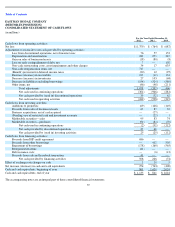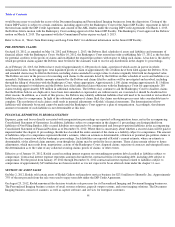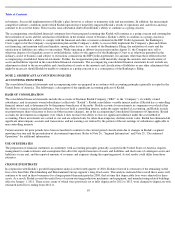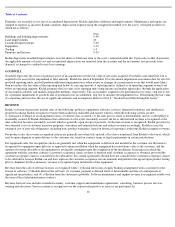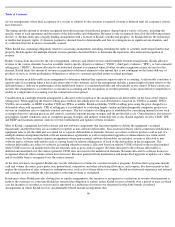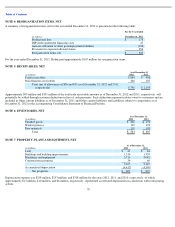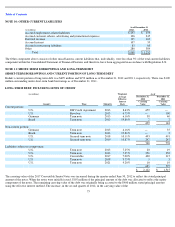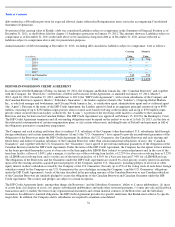Kodak 2012 Annual Report Download - page 71
Download and view the complete annual report
Please find page 71 of the 2012 Kodak annual report below. You can navigate through the pages in the report by either clicking on the pages listed below, or by using the keyword search tool below to find specific information within the annual report.
Table of Contents
have enforceable exclusivity provisions and include claw-back provisions entitling Kodak to a pro rata reimbursement if the customer does not
fulfill its obligations under the contract.
Kodak may offer customer financing to assist customers in their acquisition of Kodak’s products. At the time a financing transaction is
consummated, which qualifies as a sales-
type lease, Kodak records equipment revenue equal to the total lease receivable net of unearned income.
Unearned income is recognized as finance income using the effective interest method over the term of the lease. Leases not qualifying as sales-
type leases are accounted for as operating leases. Kodak recognizes revenue from operating leases as earned.
RESEARCH AND DEVELOPMENT COSTS
Research and development (“R&D”) costs, which include costs incurred in connection with new product development, fundamental and
exploratory research, process improvement, product use technology and product accreditation, are expensed in the period in which they are
incurred. The acquisition-date fair value of R&D assets acquired in a business combination is capitalized.
ADVERTISING
Advertising costs are expensed as incurred and are included in Selling, general and administrative expenses in the accompanying Consolidated
Statement of Operations. Advertising expenses amounted to $88 million, $162 million, and $194 million for the years ended December 31, 2012,
2011, and 2010, respectively.
SHIPPING AND HANDLING COSTS
Amounts charged to customers and costs incurred by Kodak related to shipping and handling are included in net sales and cost of sales,
respectively.
IMPAIRMENT OF LONG-LIVED ASSETS
Kodak reviews the carrying values of its long-lived assets, other than goodwill and purchased intangible assets with indefinite useful lives, for
impairment whenever events or changes in circumstances indicate that the carrying values may not be recoverable. Kodak assesses the
recoverability of the carrying values of long-lived assets by first grouping its long-lived assets with other assets and liabilities at the lowest level
for which identifiable cash flows are largely independent of the cash flows of other assets and liabilities (the asset group) and, secondly, by
estimating the undiscounted future cash flows that are directly associated with and that are expected to arise from the use of and eventual
disposition of such asset group. Kodak estimates the undiscounted cash flows over the remaining useful life of the primary asset within the asset
group. If the carrying value of the asset group exceeds the estimated undiscounted cash flows, Kodak records an impairment charge to the extent
the carrying value of the long-
lived asset exceeds its fair value. Kodak determines fair value through quoted market prices in active markets or, if
quoted market prices are unavailable, through the performance of internal analyses of discounted cash flows.
In connection with its assessment of recoverability of its long-lived assets and its ongoing strategic review of the business and its operations,
Kodak continually reviews the remaining useful lives of its long-lived assets. If this review indicates that the remaining useful life of the long-
lived asset has changed significantly, Kodak adjusts the depreciation on that asset to facilitate full cost recovery over its revised estimated
remaining useful life.
INCOME TAXES
Kodak recognizes deferred tax liabilities and assets for the expected future tax consequences of operating losses, credit carry-forwards and
temporary differences between the carrying amounts and tax basis of Kodak’s assets and liabilities. Kodak records a valuation allowance to
reduce its net deferred tax assets to the amount that is more likely than not to be realized. For discussion of the amounts and components of the
valuation allowances as of December 31, 2012 and 2011, see Note 18, “Income Taxes.”
EARNINGS PER SHARE
Basic earnings per share computations are based on the weighted-average number of shares of common stock outstanding during the year. As a
result of the net loss from continuing operations presented for the years ended December 31, 2012, 2011, and 2010, Kodak calculated diluted
earnings per share using weighted-average basic shares outstanding for each period, as utilizing diluted shares would be anti-dilutive to loss per
share. Weighted-average basic shares outstanding for the years ended December 31, 2012, 2011, and 2010 were 271.8 million, 269.1 million,
and 268.5 million shares, respectively.
67


